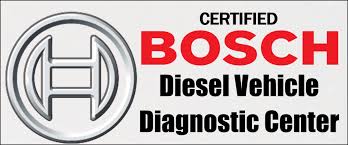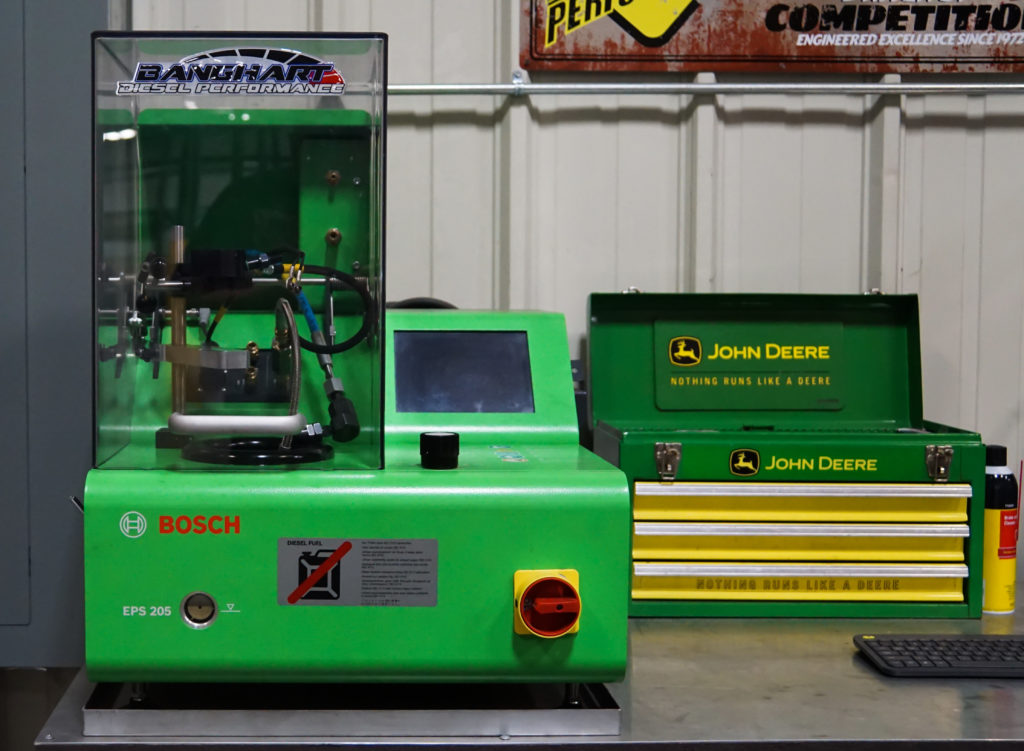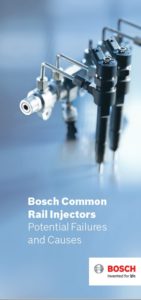Banghart Diesel & Performance can now test common rail diesel injectors in-house! In the past, we had to send injectors out to be tested, this would almost always lead to downtime and delays in getting the information we needed to do the job correctly. In some cases, customers would decline having their injectors tested in order to speed up turn around time on the repair process. Not anymore! At Banghart Diesel & Performance we have the proper equipment to do the job right here!

As an Authorized Bosch Diesel Vehicle Diagnostic Center, we utilize a Bosch EPS 205 common rail test stand. This one piece of equipment will tell us all we need to know about the health of your injectors. Whether it’s just a simple flow test to see how well the injectors deliver fuel, or a detailed report to show how much life could possibly be in the injectors you have, we can do it.
The Bosch EPS 205 test stand does several things:
- Verify amount of return flow.
- Verify fuel delivery at a wide range of manufacturer set points based on duration and pressure.
- Verify no external leaks.
- Test the integrity of the electrical solenoid and/or piezo stack.
- Provide a report card on the entire set of injectors tested to see how well the set is balanced.

At the end of the day, you want to know what’s going back into your truck. The last thing you want to do is take a guess on something that could, if not functioning properly, ruin your engine.
Why should I get my injectors tested?
That’s a good question. Here’s a few examples of why it’s a good idea.
Return Flow
An injector with high return flow is not always noticeable when driving the vehicle. However, it does indicate the amount of internal wear within the injector. The higher the quantity, the less life you typically have left. If you can spot this during a repair job, you can replace the injectors now rather than later and save some labor costs down the road. Also, high return flow affects fuel delivery and the balance of the injector set. High return flow can change the timing and quantity of the fuel delivery causing that cylinder to run hotter. Most often when we see a melted piston in an engine, it’s due to high return flow on the injector for that cylinder. Another side effect of high return flow, is the fact that it robs volume output from the high pressure fuel pump. This can cause hard starts or drop fuel rail pressure under a load due to the pump not able to hold sufficient pressure. Think of it as a “leak” in the system of sorts. If the high pressure pump has a fixed volume, it is not able to sustain the required pressure when there is an excessive leak in the system.
Fuel Delivery Quantity
It’s a good idea to have a set of injectors that are balanced out well. You want to see them within a few percentage points of each other. If the injectors have an excessive fuel delivery spread across the set, you will experience rough idle and excessive exhaust emissions. The injectors with the highest delivery will cause those cylinders to run hotter than the others. Engine efficiency and fuel economy is also affected by variations in fuel delivery.
External Leaks
A number of vehicles in service today have their fuel injectors located under the valve cover. Some of these applications can require up to 12 hours just to access the fuel injectors! Discovering you have fuel in your oil is the last thing you want to find after replacing the injectors. By testing them, we can verify everything is sealed up and your not going to be getting any surprises later on.
Electrical Component Operation
It’s not uncommon for a diesel to run for hundreds of thousands of miles before getting any attention to the fuel system if they have been properly maintained. Even if you do your best to avoid mechanical component wear within the injector, you still have electrical components that can fail. Most electrical components will fail under different temperature environments. We can put these items through many comprehensive tests to simulate the environment they are exposed to in the vehicle. Most times, these items will not fail when they are cold, and it is not easy to test them on a hot vehicle.



